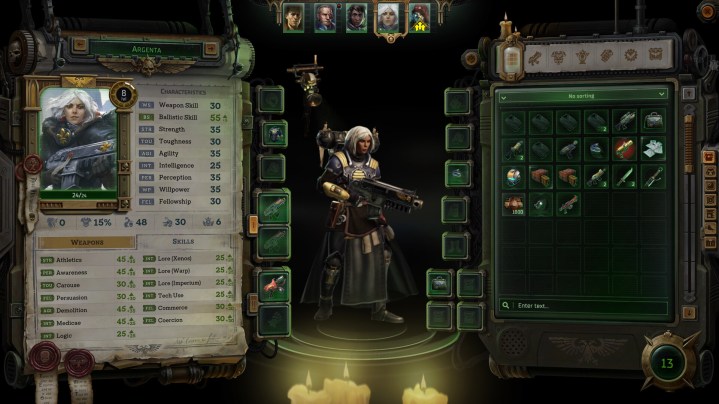The tremendous success of Baldur’s Gate 3 can either be seen as a blessing or a curse on the video game industry.
On one hand, it’s a landmark moment for the CRPG genre that shows players are hungry for genres that have long been written off as niche. That should hopefully rub off on other upcoming games, giving them a larger audience. On the other hand, Baldur’s Gate 3 is so good that it’s already creating some unreasonably high expectations. Its release triggered a discourse among players who argued over whether or not the standard of quality set in Larian Studios’ game is a realistic bar for most studios. Any CRPG launching in the next few years will undoubtedly be caught in that crossfire, whether they want to be or not.
That’s the sticky position Warhammer 40,000: Rogue Trader finds itself in. Giving Warhammer the CRPG treatment for the first time ever, the upcoming game is certainly a massive undertaking. Developer Owlcat Games, known for its work with the Pathfinder series, is aiming to create an enormous, 100-hour game that fleshes out Warhammer lore in ways we’ve never seen in a video game. That’s an ambitious task, but one that’s going to invite some high standards.
Fortunately, it seems that Owlcat is prepared to meet them. Ahead of Gamescom, I got a long look at Warhammer 40,000: Rogue Trader. Though I only got to see one complex battle, it was enough to convince me that the studio has something big on its hands. Though what remains to be seen is how normal Baldur’s Gate 3 fans can be about it.
Big battles …
In its full, final form, Warhammer 40,000: Rogue Trader will be a massive RPG full of meaningful player choices and a sprawling story. My demo, though, was solely focused on its combat system. And that’s a good thing, because it’s the area where it really feels like Owlcat is going to stand out from the pack.
The gameplay segment I saw was a battle somewhere past the 80-hour mark. My crew of six figurine-like heroes touched down on a planet and walked down into a Necron den. That kicked off a long grid-based, turn-based battle against five Necrons, a few healing drones, and some teleporters that spawned in new monsters intermittently. After placing each team member in an opening action phase, a developer began showing me just how much players can do in a battle — and it’s a heck of a lot.

Each character has five action points that can be spent on their turn, which can be split between attacks and a slew of abilities. In my session, I saw late-game characters with 20 abilities equipped, as well as two different sets of weapons. What’s notable about that large of a turn economy is that it really enables players to create and execute specific strategies each battle, rather than launching attacks until each enemy is dead. The 45-minute battle I witnessed revolved around support companions stacking buffs on one damage-heavy character. That incrementally built up his power as the battle progressed until he was dealing over 170 damage on a hit. Meanwhile, a pair of ranged characters controlled the eastern side of the arena, with one continually buffing the other and giving them extra turns.
Even more unique is Rogue Trader’s momentum system. The better players do in battle, the more a bar fills that’s shared between all characters. When it hits a certain threshold, a character can initiate a sort of super ability that lets them zip anywhere they want on the map and pull out a powerful attack phase capable of wiping out multiple enemies in one go. Each character can only use it once per battle, but another character can activate it the next time the bar fills up. On the flip side, there’s an anti-momentum system which lets players activate that skill if they’re doing badly … though it’ll come with some negative effects too.
… and bigger expectations
After an arduous fight, the Necrons were wiped out and the developers chatted about the project more generally. While Warhammer games are a dime a dozen these days, this one is specifically important for Warhammer company Games Workshop. That’s because it’s the first true CRPG in the tabletop franchise’s history, and one that’ll show parts of the universe that have never been depicted in a game before. Because of that, Games Workshop is heavily involved in the project, with Owlcat describing it as a full collaboration between the two.
That alone puts some pressure on the project, but there was another elephant in the room. Baldur’s Gate 3 came up several times during our chat, mostly notably when the developers gave me a peek at the game’s character creator and tried to set my expectations for how detailed it is. When asked about how they felt Baldur’s Gate 3 could impact their game, the team pointed out some of those complicated feelings that come with following up a genre-defining success.

Owlcat is no stranger to that position; the studio’s Pathfinder: Kingmaker launched right behind Larian Studios’ Divinity: Original Sin 2, after all. However, it doesn’t seem too intimidated. The Owlcat team is confident that it has different strengths from Larian that allow it to stand apart. That’s something I can already see in the project thanks to a deep combat system that makes for some engaging tactical battles. The studio also stresses that player agency is going to be a major focus, which is what I’m really itching to see in a full playthrough.
Fortunately, Rogue Trader won’t launch directly after Baldur’s Gate 3. Owlcat is being careful not to rush the project out the gate and won’t commit to any form of release window until they’re certain they can hit it. Frankly, that might be the most strategic move the studio could make right now. Baldur’s Gate 3 showed us that a great CRPG requires a fair bit of patience to do right, and it seems like Owlcat understands that. If it can stick the landing, you might just be looking at the genre’s next big moment.



